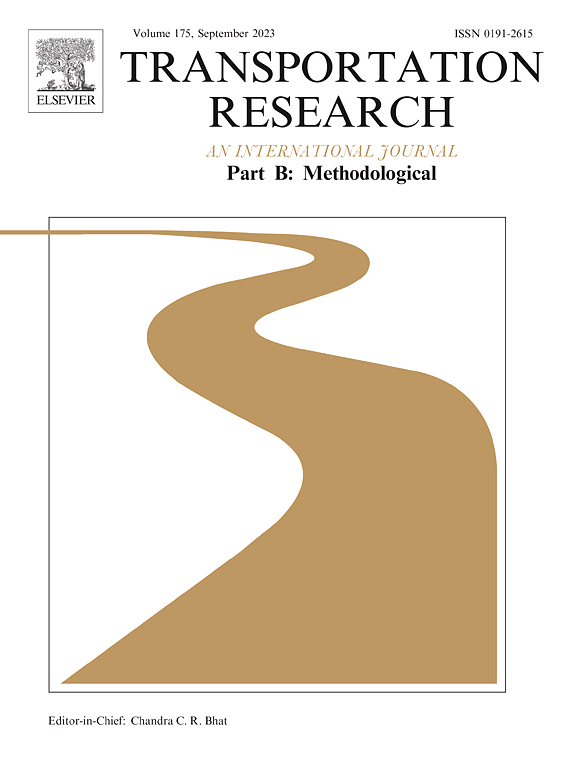The corridor problem: More comprehensive results on the no-toll equilibrium
IF 6.3
1区 工程技术
Q1 ECONOMICS
引用次数: 0
Abstract
The basic corridor problem is significant for the study of traffic congestion and travel behavior, paving way to insights into the spatial dynamics of rush-hour traffic flow pattern. In light of the fact that previous studies have yielded only preliminary results, this paper considers both early and late commuters to provide more comprehensive results. By introducing the continuous schedule preference (CSP), we determine the form and characteristics of the equilibrium solution, deduce the complete governing equations consistent with the departure timing decision, and obtain the explicit expression of the solution through an ingenious numerical analysis technique. We find and confirm that the set of equilibrium departure time-space points (departure set) with early and late commuters is horn-shaped, and the tip of the horn is situated in the central business district (CBD). This is significantly distinct from the departure set when discontinuous schedule preference is assumed. Moreover, the commuting density distribution increases first and then decreases from residential boundary to CBD, which is consistent with the data we have observed in the real world. This study provides avenues for gaining insights into the propagation characteristics of traffic flow, constituting a substantial advance in the corridor problem.
走廊问题:关于不收费均衡的更全面的结果
基本廊道问题对于研究交通拥堵和出行行为具有重要意义,为深入了解高峰时段交通流格局的空间动态规律奠定了基础。鉴于以往的研究只得出了初步的结果,本文同时考虑了早通勤者和晚通勤者,以提供更全面的结果。通过引入连续调度偏好(CSP),确定了平衡解的形式和特征,推导出了与出发时间决策一致的完整控制方程,并通过巧妙的数值分析技术得到了解的显式表达式。我们发现并证实了有早、晚通勤者的均衡出发时空点集(出发集)呈喇叭形,喇叭形的尖端位于中央商务区(CBD)。这与假定不连续调度偏好时的出发集明显不同。从居住区边界到CBD,通勤密度分布呈现先上升后下降的趋势,这与我们在现实世界中观察到的数据一致。该研究为深入了解交通流的传播特性提供了途径,在走廊问题上取得了实质性的进展。
本文章由计算机程序翻译,如有差异,请以英文原文为准。
求助全文
约1分钟内获得全文
求助全文
来源期刊
CiteScore
12.40
自引率
8.80%
发文量
143
审稿时长
14.1 weeks
期刊介绍:
Transportation Research: Part B publishes papers on all methodological aspects of the subject, particularly those that require mathematical analysis. The general theme of the journal is the development and solution of problems that are adequately motivated to deal with important aspects of the design and/or analysis of transportation systems. Areas covered include: traffic flow; design and analysis of transportation networks; control and scheduling; optimization; queuing theory; logistics; supply chains; development and application of statistical, econometric and mathematical models to address transportation problems; cost models; pricing and/or investment; traveler or shipper behavior; cost-benefit methodologies.

 求助内容:
求助内容: 应助结果提醒方式:
应助结果提醒方式:


